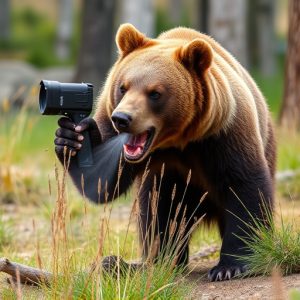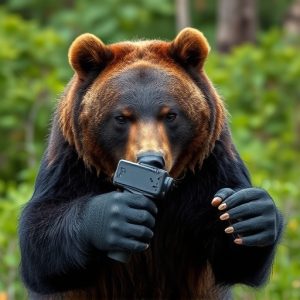Bear Deterrent Spray Range: Protection & Accidental Discharge Prevention Tips
Understanding bear behavior is key to selecting and using bear deterrent spray effectively. Grizzlie…….
Understanding bear behavior is key to selecting and using bear deterrent spray effectively. Grizzlies and other bears have keen senses, particularly smell, allowing them to detect chemicals from far distances. Accidental discharge prevention is crucial; proper training, understanding wind patterns, and maintaining safe distances are essential practices in bear country. Effective sprays rely on strong scent to trigger bears' natural aversion response, creating a safe buffer zone. Range effectiveness varies based on distance, wind conditions, and spray type; higher capsaicin concentrations offer longer protection but increase accidental discharge risk. Preventing accidental discharges involves thorough inspection, proper storage, mindful surroundings, responsible usage, and training for optimal protection in bear country. Selecting the right spray depends on environment and potential encounters, with advanced nozzles and triggers enhancing user safety and resource conservation.
“Bears are an integral part of many ecosystems, but their proximity to human habitats poses a unique challenge. This article delves into bear deterrent spray, a popular tool for maximum range protection during outdoor adventures. We explore the science behind these sprays and the factors influencing their effectiveness.
Understanding bear behavior and their sensitivities is key to safe usage. Learn about accidental discharge prevention tips, as well as how to choose the best spray for your specific needs, ensuring a peaceful encounter with these majestic creatures.”
- Understanding Bear Behavior and Their Sensitivities
- The Science Behind Bear Deterrent Spray
- Factors Affecting Maximum Range Protection
- Accidental Discharge: Prevention Tips and Strategies
- Choosing the Right Bear Deterrent Spray for Your Needs
Understanding Bear Behavior and Their Sensitivities
Understanding bear behavior is key when considering bear deterrent spray for maximum range protection. Bears, especially grizzlies, have an excellent sense of smell and are highly sensitive to certain stimuli. They can detect chemicals like those in bear spray from miles away. This means that effective bear deterrents need to go beyond simply repelling bears; they must also avoid accidental discharge that could harm humans or the environment.
Prevention of accidental bear spray discharge is crucial. Bear spray is designed to be a last resort for self-defense, and its effectiveness relies on responsible use. Proper training, understanding wind patterns, and maintaining a safe distance are essential practices when venturing into bear country. By recognizing their behaviors and sensitivities, individuals can better navigate potential encounters and make informed decisions regarding the use of bear deterrent spray.
The Science Behind Bear Deterrent Spray
The effectiveness of bear deterrent spray lies in its ability to emit a powerful scent that bears find repulsive, creating a safe buffer zone for campers and hikers. The spray is designed to be easily detectable by bears, with ingredients that trigger an instinctive aversion response. When used correctly, it can provide up to 30 feet (or more) of protection, giving users valuable time to retreat or deter an approaching bear.
Key to its success is the precise formulation and application method. The spray’s nozzle is engineered to project a fine mist, ensuring even coverage and minimizing the risk of accidental discharge. This technology goes a long way in preventing accidental bear spray discharges, which can occur when the can is jostled or mishandled, potentially causing harm to the user and waste of valuable resources.
Factors Affecting Maximum Range Protection
The maximum range protection offered by bear deterrent spray is influenced by several key factors. One critical aspect is the user’s distance from the potential bear encounter. The further away, typically, the greater the effective range of the spray. However, it’s essential to remember that wind conditions can significantly impact this range; a strong breeze can carry the spray back towards the user, reducing its overall effectiveness and potentially leading to accidental discharge.
Another factor is the specific type of bear deterrent spray being used. Different formulations have varying concentrations of capsaicin, the active ingredient responsible for the burning sensation that deters bears. Higher concentrations generally offer longer-range protection but also increase the risk of accidental discharge due to its potency. Additionally, weather conditions play a role; heat and humidity can affect the spray’s performance, while cold temperatures may alter the user’s dexterity, impacting their ability to accurately apply the spray during an encounter.
Accidental Discharge: Prevention Tips and Strategies
Accidental discharge of bear deterrent spray can be a serious issue, potentially causing harm to both individuals and wildlife. To prevent such incidents, it’s crucial to follow specific tips and strategies. First, always inspect the spray canister before each use, checking for any damage or leaks. Ensure the nozzle is secure and the safety lock is engaged when not in use.
When carrying the spray, keep it out of reach of children and pets, stored in a secured container or pouch. During outdoor activities, be mindful of your surroundings; avoid surprising bears, as this can trigger an impulsive discharge. Maintain a safe distance from bears and use the spray only as a last resort when faced with an aggressive or defensive bear encounter. Regularly practicing the proper usage technique with a training partner or in controlled environments can also help prevent accidental discharges.
Choosing the Right Bear Deterrent Spray for Your Needs
When selecting a bear deterrent spray, understanding your specific needs is key to ensuring maximum effectiveness and safety. Different environments and potential encounters demand varying levels of protection. For instance, if you’re primarily hiking in areas with known black bear populations, a spray designed for short-range deterrence might suffice, as black bears generally react to loud noises and movements rather than distance. However, for those adventuring in grizzly bear country or remote locations where encounters could be at longer distances, opting for a high-end spray with a significant range advantage is crucial.
Accidental discharge prevention features should also be considered to ensure user safety. Look for sprays that incorporate advanced nozzles and triggers designed to mitigate accidental activations, especially when hiking or in dynamic environments. These mechanisms can help prevent unwanted bear spray releases, ensuring your safety and the conservation of valuable resources.
Understanding bear behavior, the science behind deterrents, and the factors influencing range are key steps in ensuring your safety. By choosing the right spray and practicing prevention strategies, including avoiding accidental discharge, you can effectively protect yourself while enjoying the outdoors. Remember, knowledge is power when navigating potential bear encounters, making these measures a vital part of any outdoor adventure in areas where bears roam.


